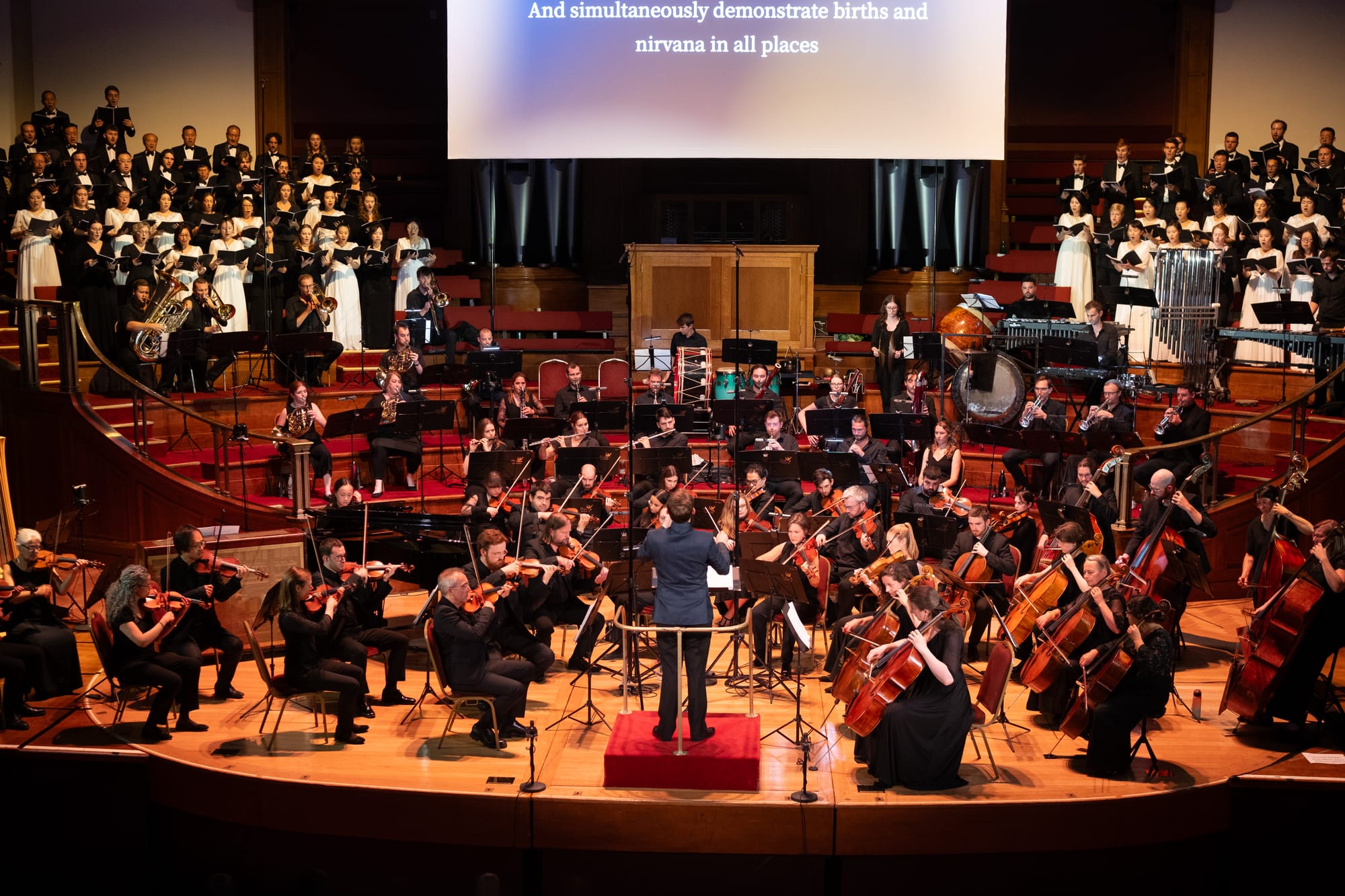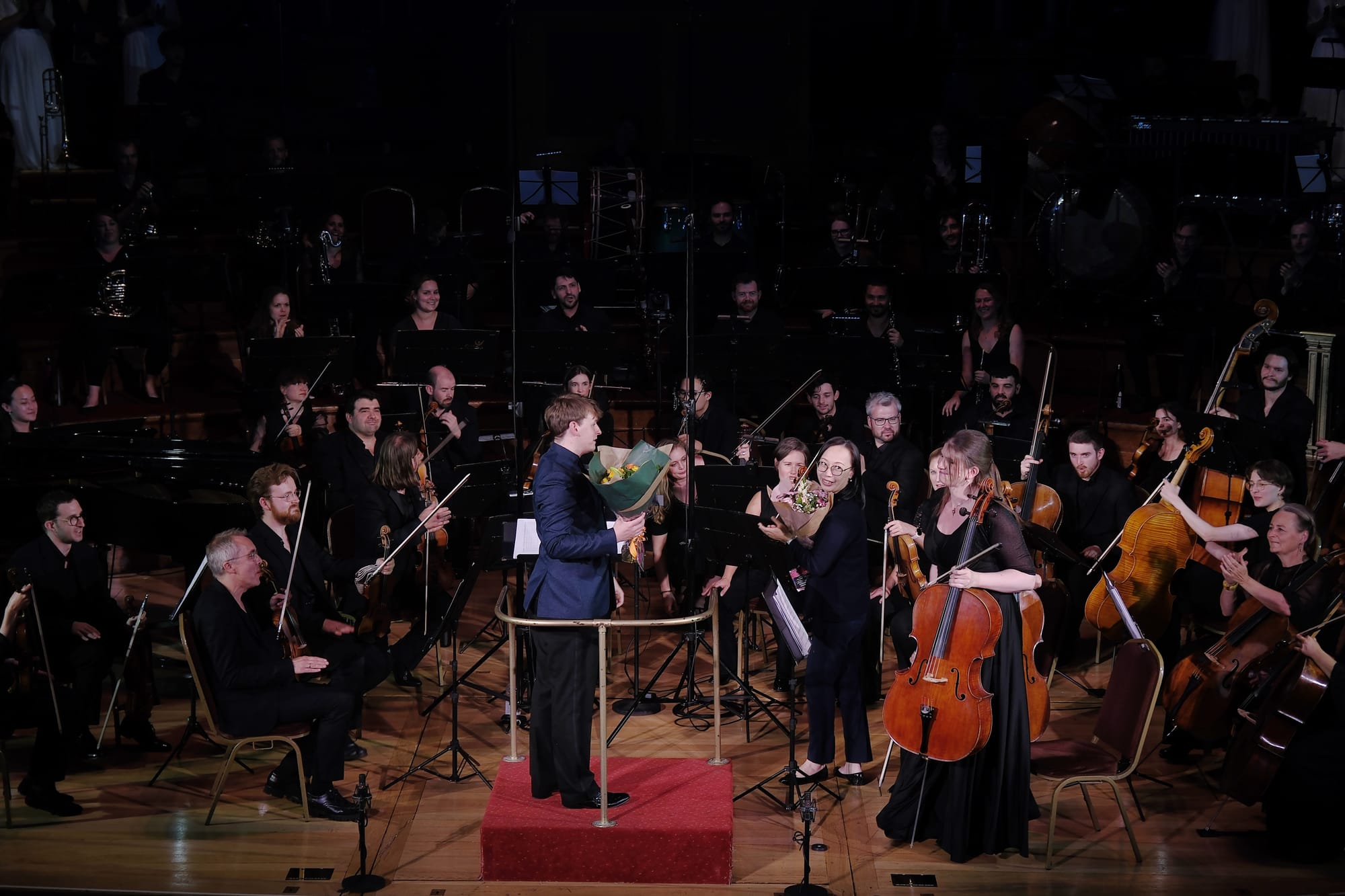
Zou Ye Symphony Kūkai (2023). The Choir of Central Conservatory of Music; London Chinese Philharmonic Choir; Scherzo Ensemble; Orpheus Sinfonia / Derrick Morgan (conductor); Charles Mutter (leader/solo violin); Rebecca Hepplewhite (solo cello). Westminster Hall, London, 17.08.2024
Born in the Hunan Province of China in 1957, composer Ye Zou (as shown on the concert programme, but rendered on Wikipedia and elsewhere as Zou Ye) was one of the first graduates from the Wuhan Conservatory of Music. He became the resident composer at the Children’s Theare in Beijing in 1992 , and his association with drama extends to his various film scores, including Yin Li’s The Knot (2005) and the same director’s Zhang Side (2004), Huang Jianzhong’s 1991 film The Spring Festival and a new score for Wu Yonggang’s 1934 film The Goddess. Zou also became the Honorary resident Composer for the China Philharmonic Orchestra.
So, here is a major, 90-minute work by Zou Ye, Conductor Yu Long and the China Philharmonic Orchestra premiered the piece at the Lanzhou Grand Theatre in the provincial capital of Gansu, working with the chorus of the Lanzhou Concert Hall. Soon after, it was performed in celebration of the 45th anniversary of the Sino-Japanese Treaty of Peace and Friendship conducted by Yu Long in both Kyoto and Tokyo. The Kūkai Symphony addresses Buddhism, the Buddhist monk Kūkai’s life in Japan, and his promotion of Buddhism there. It is written in celebration of the 1250th anniversary of Kūkai’s birth.
Here is the full Tokyo performance, conducted by Long Yu:
Born Seiki no Meo in 774 and posthumously referred to as ‘Kōbō Daishi’ (The Grand Master who propagated the Dharma), Kūkai was actually born in Japan, but travelled to China to study Tangmi Buddhism (唐密, the Chinese equivalent to Vajrayana, the so-called “Damond Vehicle”: see this article on Chinese Esoteric Buddhism) during the Tang Dynasty. He then founded the Japanese equivalent (known as Shingon). He chose Mount Kōya as. holy site and it thee where he died in the year 835, aged 60.
Kūkai was what in modern-day terminology we might call a polyglot; perhaps the best parallel for Westerners is Hildegard of Bingen. Hildegard is known in musical circles for her exquisite chants (think Hyperon’s magnificent A Feather on the Breath of God); Kūkai was not only a religious leader, but also a poet, an artist, and a calligrapher.
So, fast forward from 835 to 2024, and from Mount Kõya to Westminster Hall where.a packed audience sat expectantly for the European premiere of Symphony Kūkai. We were all given what looked like a programme, but was actually labelled ‘Symphony Kukai Introduction Handbook’ (plus an envelope including a bookmark and some postcards).
The orchestra was the Orpheus Sinfonia (‘Sinfonia’ in this context was a little misleading as the stage was packed); the Scherzo Ensemble is actually a choir, a professional platform for emerging artists, and these were joined by The Choir of Central Conservatory of Music (CCOM Choir) and the London Chinese Philharmonic Choir (LCPC, founded 2013). The choirs were prepared by ‘Chief Choral Conductor’ Chen Bing.
The symphony is both beautiful and dramatic. It does need an excellent conductor, though, not just to marshal the huge forces but also to convey the breadth of the music: a long view is mandatory for success. Derrick Morgan has this: he seemed to know the score inside-out.

There is a notably filmic aspect to the score (unsurprisingly, given Zou’s activity in that genre) and yet Morgan managed to avoid schmalz and unnecessary emotionalism at all times. The orchestral strings were well-balanced (importantly, the violins did not lose tone high in their register).
There is a pronounced full stop around five minutes into the first movement; it seems as if the first movement is short, but the silence is intended as a structural articulator (it is there also in Long Yu’s performance of the symphony in Tokyo, available on YouTube, above, which implies this is specifically requested). At other times, the chiming of a bell acted as a structural articulator (interestingly, a truck Tibetan bowl is used as a chiming instrument, also). And if bell chimes invite in the idea of ritual, so it was: in the meditation on Ākāśagarbha Boddhisatva (one of the eight great boddhisatvas). In response, a plaintive cor anglais sings its mournful song (Olivia Fraser), garlanded by flute arabesques. The text is, as one might expect, full of references to the beauty of Nature, of Spring flowers in full bloom. But balancing that tissue-delicate beauty is he strength of Buddhism enshrined sonically in the trumpet-encrusted hymn to Buddhist praxis crowns the first movement.
The second movement, ‘Pursuing Study in Tang China and Sustaining the Dharma Heritage,’ is full of unashamedly long, lyrical lines. There is one trumpet moment that in the London performance seemed to reference Janáček’s Sinfonietta strongly (27’38in the YouTube Tokyo performance link below). More importantly, there is a carefully-planned arrival here on the word ‘Varocana’, a powerful concept interpreted in Chinese Buddhism as the supreme Buddha-body, a vessel of ultimate reality; this after another of Zou’s structural Luftpausen. Wordless chorus is used effectively, too, as yet another strand of the overall fabric.
There is no missing the use of Chinese melody at the opening of the third movement, ‘Spreading Esoteric Training in Japan and Turning the Dharma Wheel’. It really is very lovely, but where the music gets really interesting is in the use of traditional (or traditional-based) melody as low string destabiliser to impart a sense of unease. Far from this being a traditionally (from the Westen perspective) ‘choral’ symphony, the composer offers long purely orchestral tracts, long explorations of material that eventually lead to the choir’s words. In this third movement, we meet Kūkai’s master, Huiguo (746-805) and the teachings of the Tripitaka.
The sheer variety of expression the composer calls upon is vast, from almost comedic to truly apocalyptic to the Peace Profound of the fourth panel, ’Dwelling in Vairocana Pure Land and Having Great Compassion for All Living Beings,’ all aspects well sculpted and characterised here. If there was the occasional blip in ensemble (the fifth section, ’Widely Spreading Esoteric Teaching and Benefitting Sentient Beings,’) they were few and far between. The final section, ‘Abiding in Esoteric School and Accomplishing the Mission of Buddha,’ includes a return of the bells and brass from earlier. The movement feels like a true culmination of all that came before it as well as something of a summation. The choral aspect is more complex here with much imitation (call-and-response, perhaps) and counterpoint. There is a pronounced Mahlerian element to the great choral climax of the work’s close, down to the high soprano’s elevation of pitch and crashing tutti arrival, plus the extended preparation for that elevating ending.
The chorus in London was notably powerful, almost overwhelming at times, while the orchestra gave their all, maintaining concentration at almost all times. This performance was enough to convince this listener, a least, that Zou Ye’s symphony is a major achievement.
All photos of this event © Tianguzhiyin Culture Media Co. Ltd
Elsewhere, Ye Zou has composed music for an iconic Chinese film, The Goddess:
And here’s a film review:)
Of Ye Zou’s other activities, here is Wulan Tuoga in his arrangement for cello ensemble:
Here’s a co-written symphony with Fang She to open the 23rd Beijing Music Festival:
This next is a LOT of fun, The Spring of Xinjiang:
Finally, Long Yu conducts one of Ye Zou’s arrangements:
Lots to enjoy, then, and plenty more, surely, to discover.










